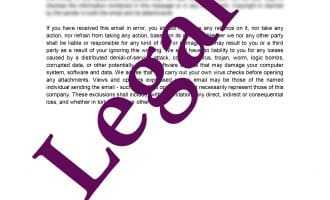Email Disclaimer
Our Email Disclaimer template:
- Drafted by a UK solicitor for reliability
- Covers the legal requirements
- Cost-effective legal peace of mind
- Quick and simple to use

How Does It Work?
-
1. Download
-
2. Edit
-
3. Print
-
4. Sign
Emails have become sources for liability suits lately, so to protect yourself from emails that your employees might send, you need to use an Email Disclaimer.
About our Email Disclaimer
Our Email Disclaimer template is fully adaptable, so that you can adapt it to your specific needs. This document will claim confidentiality over the material that is in any of the emails, disclaim liability for attached viruses and disclaim liability for personal opinions or comments that your employees might make.
The Email disclaimer might appear as a footer to your business emails. It is a brief template that will help protect you from these issues.
We have also included the business stationery requirements, as many businesses are unaware of these and what information on their business the law requires you to include in all business emails.
Because we have all of our e-commerce templates drafted by experienced UK lawyers, they are reliable and easy to implement.
The wording below is a slightly abbreviated version of our guide to the email disclaimer, which comes with the template when you buy it.
If you need the full suite of business compliance templates, then click on the link.
Guide to our Email Disclaimer
Under UK law, certain information must be included in business correspondence, which applies also to emails. We include this information in the suggested wording of our email disclaimer template.
Most organisations also include a disclaimer and confidentiality warning, although these are not legal requirements. NB there is some doubt that a confidentiality notice or a generic disclaimer in an email will be effective in English law and accordingly you should still be careful:
- that you attach only the correct attachments;
- that you send emails to the correct recipient (often using the “reply to all” button is not a good idea);
- that in any reply to an email, you check that all the contents of all earlier emails in the chain are suitable for you to send on to the intended recipients;
- that your emails do not include viruses, by the use of:
1. appropriate anti-virus software, and
2. other security protections for your website and email server;
- that you properly train your staff, for example, not to use the company emails for private correspondence, to produce suitable professional emails, and not include spurious, unreliable or defamatory material or to express abusive or embarrassing opinions in such correspondence; and
- that the wording of emails is not casual and sloppy, but professional and well-thought through. Emails should be treated as professionally as a letter would be.
Using the Email Disclaimer
Most organisations put the confidentiality notice at the end of the email. However, it is better to put it at the top of the email. This is so that it is seen and read before the main contents of the email are read.
We would advise:
- that you include the information in the first paragraph of the document about your business in a decent sized font,
- but that you can include the information in the other 2 paragraphs in a smaller font (but still one that is readable).
Paragraphs in this Email Disclaimer
First paragraph
Insert your full company or LLP name (exactly as registered) and other details where indicated. You must include this information somewhere in all business emails. If the company is exempt from using “Limited” or “Ltd” in its name, then it must additionally state that it is a limited company.
A company that is a registered charity must also state it is a charity, unless its registered name includes either “charity” or “charitable”.
If you include the name of any director(s) (other than in the main text of the email or as signatory or sender), then you must include the names of all the directors.
For businesses that are partnerships (not LLPs), if trading under any name other than simply the names of all of the partners (e.g. Smith and Jones), then you must include:
- all of the partners’ names, and
- an address at which people can serve notices, etc on the partnership, e.g. the principal business address.
For businesses that are sole traders, if trading under any name other than simply the name of the person (e.g. Mr Smith), then you must include:
- the proprietor’s name, and
- an address at which people can serve notices, etc on the business, e.g. the principal business address.
Second paragraph
This is the confidentiality notice, in case the email has been sent by mistake to the wrong person.
Third paragraph
This is the email disclaimer itself. It covers:
- excluding liability to someone other than the intended recipient for relying on any information in it or its attachments;
- excluding liability for any computer viruses, etc that might be attached; and
- that views and opinions of employees might not be the views or opinions of the business.
Regulated organisations
If your organisation is a firm of solicitors and/or is is one that the FCA regulate, etc, then you must also add the following wording into the email disclaimer:
[NAME] is [authorised and regulated by the [Financial Conduct Authority OR Prudential Regulation Authority] [and] AND/OR [regulated by the Solicitors’ Regulation Authority of England and Wales and our profession’s code of conduct can be accessed at: www.sra.org.uk/solicitors/handbook/code/content.page. A list of the [partners/members] and their professional qualifications is open to inspection at our registered office.]
Emails sent by lawyers should also include the following statement on legal privilege at the end of the second paragraph (about confidentiality):
This email and its attachments contain material that might be subject to legal privilege.


